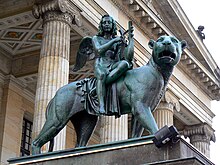Konzerthaus Berlin
The Berlin Concert Hall (German: Konzerthaus Berlin), formerly called the Berlin Theater (Schauspielhaus Berlin), is a building located in the Gendarmenmarkt square, in the center of Berlin (Germany), which is used as a concert hall and since 1994 is the headquarters of the Konzerthausorchester Berlin. It was built by Friedrich Schinkel between 1818 and 1821.
History
This building is related to its predecessor, the National Theater by Carl Gotthard Langhans, which opened on January 1, 1802 and was engulfed by fire in 1817. The theater now stands on the Gendarmenmarkt< square /i> was inaugurated in 1821, in the presence of King Frederick William III with Goethe's drama in verse Iphigenie auf Tauris. The building, commissioned by the king to Schinkel, and which became one of the most emblematic works of the architect in the Prussian capital, is of Greek inspiration on the outside, and inside it had a main hall with about 1,200 seats, together with a hall for concerts and dances. The new Königliches Schauspielhaus was devoted mainly to spoken theater, but concerts and opera performances were often scheduled. Here, already on June 16 of the same year 1821, the premiere of Carl Maria von Weber's opera Der Freischütz took place, in 1826 the premiere in Berlin of Beethoven's ninth symphony and in 1829 a concert series by Niccolo Paganini. Throughout the 19th century, the theater performed various plays by playwrights such as Friedrich Schiller, Heinrich von Kliest, Gerhart Hauptmann, August von Kotzebue, etc.
After the First World War, with the fall of the Prussian monarchy, the theater changed its name to Preußisches Staatstheater (Prussian State Theatre), and modernizes the repertoire by Leopold Jessner, who introduced the expressionist theater. Subsequently, under the direction of Gustaf Gründgens, he supported the interventions of the Nazi regime in cultural life, mainly from the Prussian Prime Minister, Hermann Göring.
Destroyed during World War II, the building was rebuilt and reopened in 1984, to celebrate 750 years of Berlin. At that time it was decided that, since East Berlin, then the capital of the German Democratic Republic (GDR), had several renowned theaters, but not a large concert hall (unlike the western sector, where the famous Philharmonie), the building would be adapted for this purpose. The decision, therefore, acquired a certain political nuance. The exterior of the building was rebuilt according to Schinkel's original idea, but the interior had to be totally redesigned, combining the original stage space and audience hall to build a new 1,600-capacity concert hall. In addition, a small room with 400 seats, the music club and a rehearsal room were added. The design of the interior spaces was made from an interpretation of Schinkel's style, based on the original small concert hall, through the use of stucco, marble and crystal chandeliers. Between 1996 and 1999, after German reunification, further restoration work was carried out.
Today, the building houses three spaces where approximately 550 shows are presented annually: the large hall (Großer Saal), the small hall (Kleiner Saal) and the Musicclub.
A selection of the works that have premiered in the theater are:
- 1799 - Die Piccolomini and Wallensteins Tod of Friedrich Schiller Nationaltheater)
- 1802 - Die Kreuzfahrer of August von Kotzebue
- 1816 - the opera Undine of E. T. A. Hoffmann
- 18 June 1821 - the opera Der Freischütz by Carl Maria von Weber, composed for the inauguration of the new building.
- 25 April 1876 - Penthesilea of Heinrich von Kleist
- 15 November 1941 - Iphigenie in Delphi by Gerhart Hauptmann
On the other hand, on December 25, 1989, to celebrate the recent fall of the Berlin Wall and the reunification of the City, Leonard Bernstein performed Beethoven's Ninth Symphony, conducting a selection of musicians from German orchestras and from the countries that had participated in the allied occupation of Germany.
Internal Composition
The interior and exterior design, including many of the composer sculptures, are the work of Christian Friedrich Tieck and Balthasar Jacob Rathgeber.
Among the sculptures exhibited in the outdoor area are: Niobe with her dead children in the pediment portico, below a scene between Eros and Psyche, and on top a bronze of Apollo. On the south façade are Orpheus and Eurydice in the underworld. On the north façade, Bacchus and Ariadne, both carved in stucco.
The original facades were covered in 1883 and 1884 with sandstone. The interior was renovated between 1904 and 1905 by Felix Genzmer. During World War II it was burned and then rebuilt between 1979 and 1984, to celebrate the 750th anniversary of Berlin. Between 1996 and 1999, after German reunification, further restoration work was carried out.
Contenido relacionado
Selknam
Jesus company
Pella (Greece)



